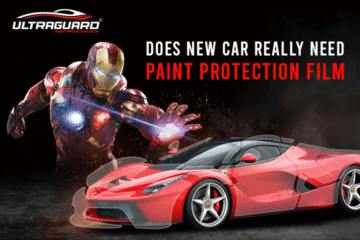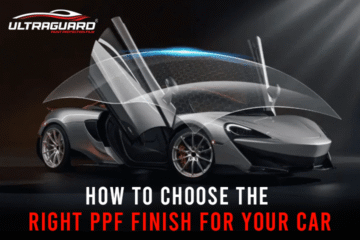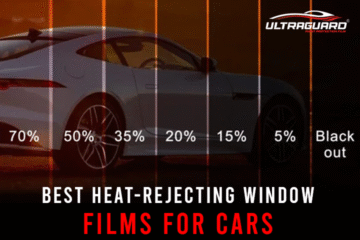The paint on your car is more than just a color; it serves as protection and adds significantly to its total worth. From common road debris to suspended chemicals, this gleaming layer has been subjected to assaults over the years. PPF vs. car insurance paint protection are the two main options that are usually taken into account when it comes to protecting the paint on your vehicle. Which is more protective, though? And do they enhance one another, or are they rivals?
This comprehensive guide will dive deep into the world of Paint Protection Film vs. car insurance for paint protection film, comparing their functionality, benefits, drawbacks, and how they assist the longevity and radiance of your car’s paint. Once you’ve read this, you’ll have a full understanding of what protects your paint best and how to make the intelligent decision for your prized possession.

How PPF Works: A Multi-Layered Defense
PPF is typically composed of several layers that exist together to provide sturdy defense:
1. Top Layer: Clear Coat
Typically, the outermost surface is stain-resistant and self-healing. Small scratches and swirl marks on the film itself can disappear when they are subjected to heat (like sunlight or hot water), leaving the film intact and appearing pleasant.
2. Polyurethane Layer
This is the interior protective layer. Its strength and elasticity allow it to absorb road waste, and shocks, preventing chips and deep scratches from reaching the car’s factory paint.
3. Adhesive Layer
This glue is made to be potent enough to stick to the painted surface of the automobile without harming it, and it will usually peel off without any residue remaining.
Key Benefits of PPF
Better Physical Protection
It gives a real physical safeguard against stone chipping, scratching, abrasions, and small impacts that car insurance will not usually pay for without paying a big deductible or affecting your premiums.
Self-Healing Properties
In case the film is scratched and swirl marked lightly on exposure to heat, it self-heals, maintaining the vehicle in mint condition.
UV Protection
It protects the vehicle from damaging UV rays, which, with time, make paint on your vehicle degrade, fade, and look dull, particularly on vehicles that spend most of their time outdoors.
Resistance to Contaminants and Stains
PPF’s slick, smooth, non-porous finish is simple to clean and resists staining from bird droppings, tree sap, insect acid, and road tar.
Maintains Resale Value
Best Paint Protection Film greatly helps to preserve or even increase your vehicle’s resale value by preventing the original paint from fading or discoloring. A car with a perfect finish is much more attractive to potential buyers. Studies show that PPF can increase resale value by 10-15% after several years.
Durable
Professional-grade PPF, if professionally applied and well maintained, will last between 5 to 10 years, providing long-term peace of mind.
What is Car Insurance? The Financial Safety Net
Car insurance is a contract between you and an insurer in which you pay a premium and the insurer promises to pay you back for any financial loss about your car. Regarding paint damage, some of the coverages under your policy apply:
1. Crash Coverage
This pays for damage to your car caused by hitting another car or object, no matter who is responsible. If your car’s paint gets scratched in an accident, collision coverage would generally come into play.
2. Comprehensive Coverage
This ensures your car against damage other than a collision. This includes damage caused by:
- Ruining (such as keying, spray painting
- Theft
- Natural mishaps (e.g., hailstorms, floods, trees falling)
- Fire
- Animal damages
- Falling things (e.g., rocks from a cliff, but not usually small road rubbish kicked up from tires).
3. Third-Party Liability Insurance
It is mandatory according to the law of India and encompasses damages caused by you to someone else’s vehicle or property. It does not cover painting damage to your vehicle as well.
How Car Insurance Covers Paint Damage?
If the paint on your car is damaged by a covered incident, you can file for a claim against your insurance company. The company will pay for the repair services after assessing the damage and generally applying depreciation (more so for older cars or for specific parts like paintwork, where depreciation is at 50% after 4-5 years), except for your deductible.
Large-Scale Incident Protection
Insurance is a large financial cushion against major, unforeseen events that can cause extensive paint damage, including accidents, large-scale trespassing, or natural disasters.
Includes Irreversible Damages
This type includes damages that are difficult or impossible to prevent, like hailstorms or hit-and-run accidents (if you have full coverage).
Legally Mandatory (Third-Party)
Not your paint, technically speaking, third-party liability is compulsory and will pay you out in case of damage to others.
Peace of Mind
Having monetary protection in the event of major damage provides you with immense peace of mind.
Disadvantages of Car Insurance to Safeguard Paint
Deductible Applies
When you file collision or comprehensive claims, you must first pay a deductible before your insurance will take care of it. If fixing minor paint damage (e.g., a few stone chips or a small scratch) costs less than or is close to your deductible, filing may not be financially sensible, as you’d pay most or all of it out of pocket.
Loss of No-Claim Bonus (NCB) and/or Increased Premiums
Making a claim, particularly for crash or fault-based incidents, may result in future insurance premium increases and/or the loss of your NCB, moving your policy into a higher bracket.
Does Not Cover Wear and Tear
Aging, wear and tear, and carelessness are not specifically covered by car insurance policies. This could be oxidation, fading, or small rock chips that build up over time due to typical vehicle wear and tear.
Does Not Avoid Harm
Insurance is a backward remedy; it sends funds after the harm has occurred. It does not prevent the harm from occurring initially.
Pre-Existing Harm Exclusion
Insurance will exclude existing paint harm on a vehicle when you purchase a new policy.
Limitations on Coverage
Policies can have exclusions or limitations on custom paint work or unauthorized changes not disclosed to the insurer.
Depreciation on Parts
Insurers decline parts, including paintwork, when settling claims, so you might not receive the full amount for the replacement of the damaged paint, especially on older vehicles.
The Synergistic Approach: PPF and Car Insurance Together
The ultimate protection for your paint is attained by using both PPF and full-coverage auto insurance.
PPF absorbs the daily punishment of minor damages, keeping your paint factory new, slowing down depreciation due to decorative flaws, and protecting you from small repair charges that could be less than your deductible. It maintains your car looking new daily.
Car Insurance is your insurance against the catastrophic and inevitable accidents that PPF cannot cover. It guarantees that in case your car gets involved in a serious accident, a serious act of vandalism, or a natural disaster, the cost of major paint (and body) repair is substantially minimized.
This dual strategy provides all-around protection for your car:
- Prevention for minor, regular damages (PPF).
- Financial recovery of the large, out-of-pocket damages (Car Insurance).
- Detailed Factors for Choosing and Applying Both
PPF vs. Car Insurance for Paint Protection: A Direct Comparison
Let’s break down the core differences in how PPF and Car Insurance protect your paint:
| Feature | Paint Protection Film | Car Insurance |
| Nature | Proactive, physical barrier | Reactive, financial compensation |
| What it prevents | Stone chips, scratches, swirl marks, UV fading, stains from contaminants, and minor scrapes. | Does not control damage; instead, it covers repair costs after specific incidents. |
| Coverage Scope | Physical protection for surfaces it covers (full or partial car). | Financial coverage for specified incidents (collisions, vandalism, natural disasters). Does not cover normal wear and tear. |
| Cost | High upfront installation cost. | Recurring premiums, plus a deductible per claim. |
| Claim Impact | No impact on insurance premiums or NCB. | Filing a claim can increase premiums and/or lead to NCB loss. |
| Resale Value | Significantly preserves/enhances original paint condition, boosting resale value. | Indirectly impacts resale value by covering major repairs, but doesn’t proactively preserve the paint’s original condition from minor daily damage. |
| Longevitty | Stays 5-10 years with proper maintenance. | Policy is typically renewed annually; coverage depends on terms. |
| Repair vs. Prevention | Focuses on preventing damage. | Focuses on repairing damage. |
| Deductile | Not applicable. | Applies per claim for collision/comprehensive. |
Know more about ultraguard PPF
When to Apply PPF?
New Car Purchasers
Applying PPF to a new car is ideal since it maintains the factory finish and protects it from day one. Paint correction is minimal or not required on new vehicles.
Luxury and High-Worth Vehicles
To maintain the high-quality look and offer greater resale value.
Average Daily Commuters
To shield against repeated exposure to road debris and elements.
Long-Term Car Ownership
If you plan to keep your car for the long term, PPF’s long-term benefit in maintaining appearance and worth is significant.
Pre-Ceramic Coating
While ceramic coatings have excellent gloss and hydrophobicity, they don’t provide the same amount of physical impact protection as PPF does. Ceramic coating is often applied on top of PPF by many owners in pursuit of enhanced shine and ease of cleaning.
After Paint Correction
If the car has already got swirl marks, scratches, or oxidation, it is extremely important to get a professional paint correction done before applying PPF. Paint Protection Film for a car will seal in any blemishes, and they will be less noticeable.
If You want to know range in PPF
PPF Setup and Upkeep
Professional Installation
PPF performance, durability, and appearance are all significantly affected by the quality of its installation. Seek installers with a good reputation and who are experienced and competent.
Healing Period
The adhesive generally takes a few days to fully cure after installation.
Cleaning Regularly
Clean your car regularly with a pH-balanced, PPF-friendly car wash shampoo. Use soft microfibre towels.
Steer Clear of Harsh Chemicals
Steer clear of using rough cleaning products that are not PPF-safe, rough polishes, and rough waxes containing strong solvents.
Rapid Contaminant Removal
To prevent etching, remove insect residue, sap, and bird droppings as far off.
Car Insurance Claims & Regards
Know The Policy
Take the time to read your collision and complete coverage limits, deductibles, and exclusions.
Depreciation
Keep in mind that depreciation will be applied to paint repair costs, specifically on older cars. Paintwork normally depreciates by 50% within 4-5 years in India.
File Early
If damaged, notify your insurance provider early.
Record Everything
Photograph the damage and the accident site (if the accident occurred).
Compare the claim to out-of-pocket
In the event of small damage, determine whether it is worthwhile to file a claim and run the risk of losing your NCB or paying higher premiums if the repair expense is significantly greater than your deductible.
Frenquently Asked Question (FAQs)
Q1: Is PPF worth the cost in India?
For many car owners in India, especially the owners of new or expensive cars, who wish to maintain the appearance of their car, preserve its resale value, and avoid numerous small paint repairs, PPF is a worthwhile long-term investment. The upfront high expense is paid off by the protection against damage that otherwise would be costly to fix or devalue.
Q2: Is PPF applicable to an old car with pre-existing paint damage?
Yes, PPF can be used on older cars. It is, however, necessary that any swirl marks, scratches, chips, or oxidations on the paint are professionally removed (paint correction) before the application of the PPF. PPF is transparent and will highlight any defects below it.
Q3: How long does a good quality PPF last in Indian climatic conditions?
Even in India’s changing climate, properly installed, high-quality PPF may last five to ten years if properly maintained. It may be put to the test by extreme heat, dust, and pollution, but high-end films are designed to resist these conditions.
Q4: Does PPF yellow due to age, especially in sunlight?
Earlier PPFs (typically PVC) used to yellow when exposed to UV. New high-end PPFs (TPU) have improved UV inhibitors and are highly resistant to yellowing and stay optically clear for the life of the material.
Q5: Is ceramic coating possible over PPF?
Yes, and it’s a popular combination! Placing a ceramic coating over PPF adds hydrophobicity (cleaner), extra gloss, and a layer of chemical resistance. It creates a very hard and low-maintenance surface. Generally, one would first apply PPF, cure it, and then apply the ceramic coating.
Q6: Does paint fading from sunlight or natural aging get covered by auto insurance?
Paint fading, oxidation, and other paint degradation brought on by extended sun exposure or aging in general are not covered by auto insurance. These are not covered by the policy because they are considered normal wear and tear.
Q7: Placing PPF will increase my car insurance premium, won’t it?
No, having PPF fitted usually does not automatically raise your car insurance premium. Insurance providers tend to see PPF as a safety device that minimizes the risk of cosmetic paint damage, which, in theory, might reduce the number of claims made in the long run. It isn’t a performance change that would increase risk.
With this knowledge of the unique functions and benefits of both PPF vs. Car Insurance for paint protection, you can create a plan of complete protection that keeps the paint of your vehicle at its best and safeguards your valuable possession in the years to come.




0 Comments